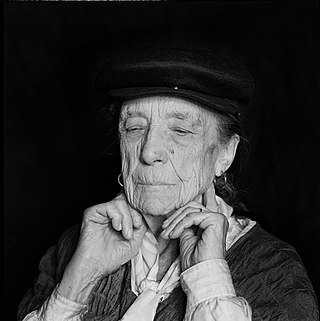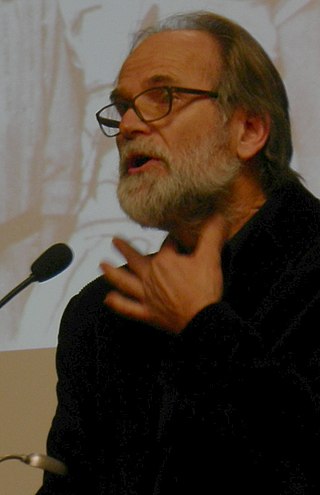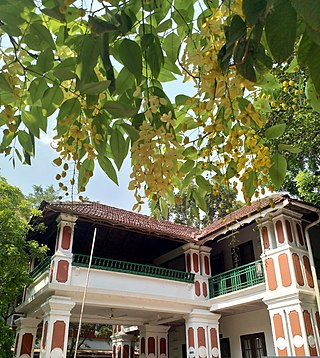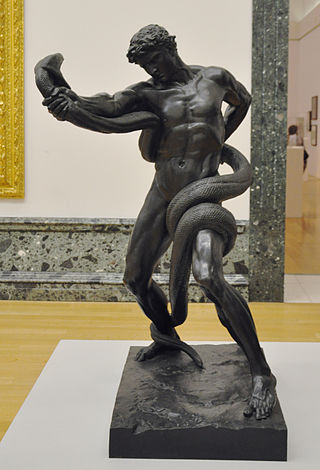
Gustav Vigeland, born as Adolf Gustav Thorsen, was a Norwegian sculptor. Gustav Vigeland occupies a special position among Norwegian sculptors, both in the power of his creative imagination and in his productivity. He is most associated with the Vigeland installation (Vigelandsanlegget) in Frogner Park, Oslo. He was also the designer of the Nobel Peace Prize medal.

Louise Joséphine Bourgeois was a French-American artist. Although she is best known for her large-scale sculpture and installation art, Bourgeois was also a prolific painter and printmaker. She explored a variety of themes over the course of her long career including domesticity and the family, sexuality and the body, as well as death and the unconscious. These themes connect to events from her childhood which she considered to be a therapeutic process. Although Bourgeois exhibited with the Abstract Expressionists and her work has much in common with Surrealism and Feminist art, she was not formally affiliated with a particular artistic movement.

The School of the Museum of Fine Arts at Tufts University is the art school of Tufts University, a private research university in Boston, Massachusetts. It offers undergraduate and graduate degrees dedicated to the visual arts.

African-American art is a broad term describing visual art created by African Americans. The range of art they have created, and are continuing to create, over more than two centuries is as varied as the artists themselves. Some have drawn on cultural traditions in Africa, and other parts of the world, for inspiration. Others have found inspiration in traditional African-American plastic art forms, including basket weaving, pottery, quilting, woodcarving and painting, all of which are sometimes classified as "handicrafts" or "folk art".

Trimpin is a German born kinetic sculptor, sound artist, and musician currently living in Seattle and Tieton, Washington.

Easky or Easkey is a village in County Sligo, Ireland. It is on the Atlantic coast, 26 miles (42 km) from Sligo and 15 miles (24 km) from Ballina, County Mayo. The village name derives from the Irish language term for fish ("iasc") and "Iascaigh" literally means "abounding in fish", due to the Easky River that lies adjacent to the village itself. Easky, as a parish, was originally called "Imleach Iseal". The area is a tourist destination on account of its scenery and water sports. Easky is a designated area on Ireland's Wild Atlantic Way tourist route.

Frederick Elliott Hart was an American sculptor. The creator of hundreds of public monuments, private commissions, portraits, and other works of art, Hart is most famous for Ex Nihilo, a part of his Creation Sculptures at Washington National Cathedral, and The Three Servicemen, at the Vietnam Veterans Memorial in Washington, D.C.

Killeenduff is a townland within the boundaries of the civil parish of Easky, County Sligo in Ireland. Located about a mile from the village of Easky, Killeenduff has an area of approximately 4 square kilometres (1.5 sq mi).

Anthony Peter Smith was an American sculptor, visual artist, architectural designer, and a noted theorist on art. He is often cited as a pioneering figure in American Minimalist sculpture.
RobertBryan Charles Kneale is a Manx artist and sculptor, described by BBC News Online as "one of the Isle of Man's best known artists."

Fred Sandback was an American minimalist conceptual-based sculptor known for his yarn sculptures, drawings, and prints. His estate is represented by David Zwirner, New York.

James Arthur Surls is an American modernist artist and educator, known for his large sculptures. He founded the Lawndale Alternative Arts Space at the University of Houston in the 1970s.
Eileen MacDonagh was born in Geevagh, County Sligo in 1956 and has worked as a sculptor since the 1980s. For her contribution to sculpture and the Arts in Ireland, MacDonagh was elected in 2004 to Aosdána, the Irish organisation that recognises artists that have contributed a unique body of work.

Jack Harte is an Irish short story writer and novelist. He founded the Irish Writers' Union and the Irish Writers Centre.

Government College of Fine Arts, Thrissur is located in the heart of the city of Thrissur in Kerala state of India. More than hundred years of existence has given a unique character to this institution in the history of art institutions in India. As a graduate level art college, this institution initiate young minds to work with the world of Art and Design and make a life in their own terms. As a Technical Commercial Industrial School, it was in 1910 that this institution started functioning. At that time, art education was basically an industrial training in order to produce skilled craftsmen and related vocational labors. During the second world war, the institution was renamed as ‘Government Trade School’. From 1943 to 1975, it was known as Government Occupational Institute. The fundamental shift from a vocational labor towards a more aesthetic ‘Fine Arts’ orientation occurred when it was upgraded as Govt.Institute of Fine Arts, in the year 1975. This was also about a raise and shift in the status of ‘artist’ in the modern sense of the term. In 1988 the title called National Diploma offered by this institute for its five year courses, gave training in Painting, Sculpture and Applied Art. In 2000, the status of this institute was raised as it got affiliated with the University of Calicut and started offering four year Bachelor of Fine Arts degree in three specialisations: Painting, Sculpture and Applied Arts. In the year 2019, a new course in Art History and Visual Studies has also started.

James Edward Kelsey is an American Abstract Expressionist sculptor best known for creating large stainless steel abstract curvilinear sculptures.

Arnold Manaaki Wilson was a New Zealand artist and educator of Māori descent. He is regarded as a pioneer of the modern Māori art movement.

Violet Amy Gillett (1898–1996) was a Canadian painter, craftsperson, watercolorists, sculptor, illustrator, author and educator known for her encouragement of the arts in the New Brunswick province.

An Athlete Wrestling with a Python was the first of three bronze sculptures produced by the British artist Frederic Leighton. Completed in 1877, the sculpture was a departure for Leighton, and heralded the advent of a new movement, New Sculpture, taking realistic approach to classical models. It has been described as a "sculptural masterpiece" and as "possibly Leighton's greatest contribution to British art". Despite its indebtedness to the Classical tradition, it can be understood as one of the first stirrings of modern sculpture in Britain as well as in Europe. The Athlete was arguably the most influential piece of English sculpture of the 19th century.














